It’s important to practice deep breathing and coughing exercises after surgery. These exercises will help your breathing, clear your lungs, and lower your risk of pneumonia. If you have been given an incentive spirometer, practice using it.
It’s also important to move and change your position often. These position changes prevent problems like a lung infection, blood clots, and weak muscles. They also make your breathing and coughing exercises work better.
Deep breathing exercises
Do these exercises 1 time every hour while you’re awake for the first 2 to 3 days after minor surgery. Continue these exercises until you go back to your normal activities after your surgery.
These exercises work better if you do them sitting up.
-
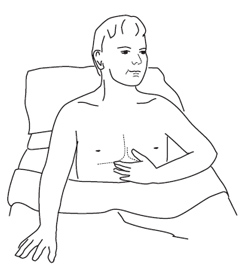 Breathe in deeply and slowly through your nose, expanding your lower rib cage (see image for where you feel your lower rib cage expand), and letting your abdomen (belly) move forward.
Breathe in deeply and slowly through your nose, expanding your lower rib cage (see image for where you feel your lower rib cage expand), and letting your abdomen (belly) move forward. - Hold for a count of 3 to 5 seconds.
- Breathe out slowly and completely through pursed lips. Don’t force your breath out.
- Rest and repeat 10 times. Rest longer if you become dizzy or lightheaded.
Credit (Image): Alberta Hip and Knee Clinic 2019
How to use an incentive spirometer
If you’ve been given an incentive spirometer, use it 1 time every hour while you’re awake. The instructions below are for the Voldyne® spirometer. If you have a different type of incentive spirometer, please read the manufacturer’s instructions.
-
 Hold the incentive spirometer upright and breathe out normally.
Hold the incentive spirometer upright and breathe out normally. - Place your lips tightly around the mouth piece, making a firm seal.
- Breathe in slowly through your mouth, raising the white piston as high as possible while keeping the yellow float between the blue lines.
- Hold your breath for a count of 3 to 5 seconds.
- Open your lips, take out the mouthpiece and breathe out slowly. The white piston should fall to the bottom of the chamber.
- Rest and repeat 10 times. Rest longer if you become dizzy or light-headed.
As you use the incentive spirometer more often, move the yellow slider on the side of the unit to the highest level you can reach. Try to reach this level with each breath, always remembering to breathe in slowly.
Coughing exercises
Coughing exercises are best done when you’re feeling comfortable. Do these exercises 1 time every hour while you’re awake for the first 2 to 3 days after minor surgery. Continue these exercises until you go back to your normal activities after your surgery. Your healthcare provider will tell you if you shouldn’t do the coughing exercises below.
Here's how to do coughing exercises:
-
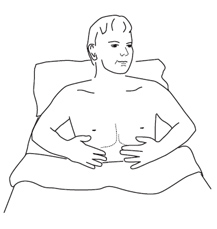 If you’re lying on your back, bend your knees (unless you have been told not to), and rest your feet on the bed. You can also do these exercises while sitting up in bed or in a chair.
If you’re lying on your back, bend your knees (unless you have been told not to), and rest your feet on the bed. You can also do these exercises while sitting up in bed or in a chair.
- Support your incision (cut from your surgery) firmly with your hands or a small pillow before you try to cough.
- Breathe in deeply and cough firmly, one time. If you cough up some mucous, spit it into a tissue. If you have a lot of mucous you may need to take a break from coughing so you don’t get too tired.
Credit (Image): Alberta Hip and Knee Clinic 2019
Foot and leg exercises
Foot and leg exercises, also help you to get better sooner and prevent problems like blood clots. You may also have SCD stockings (sequential compression devices) on your legs that inflate and deflate to keep good blood flow.
Do these exercises 1 time every hour while you’re awake.
Ankle pump
- Move both your ankles up and down for 1 minute.
- Relax both feet.
- Repeat 5 times, then relax.

Credit (Image): Alberta Hip and Knee Clinic 2019
Ankle circles
- Move both of your ankles in a circle. Start with making circles to the right for 30 seconds. Then make circles to the left for 30 seconds.
- Repeat 5 times both to the right and left, then relax.

Credit (Image): Alberta Hip and Knee Clinic 2019
Heel slides
If your surgeon says you can:
- Bend each knee one at a time, sliding your foot up along the bed and then sliding it back down.
- Repeat 5 times, then relax.
Changing positions
Change your position every hour while you are awake, or as directed by your healthcare provider. It’s important to move often to prevent problems like a lung infection, blood clots, and weak muscles.
When changing positions, follow the instructions below so that you are using your leg and arm muscles to move instead of your abdominal muscles.
To turn from your back onto your side
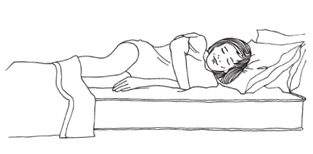
Credit (Image): Calgary Zone Allied Health, AHS
- Bend both knees, placing your feet firmly on the bed.
- Roll onto your side, keeping your shoulders and hips in a straight line (twisting your abdomen can pull on your incision).
- Hold on to the bed rail (if there is one) to finish the turn.
Call your nurse if you need help.
To turn from your side on to your back
- Bend both knees.
- Push your hand into the bed or use the bedrail to help you turn onto your back.
Sitting on the side of the bed
Once you’re allowed to get up:
-
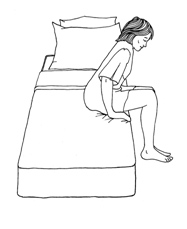 Raise the head of the bed or ask someone to raise it for you.
Raise the head of the bed or ask someone to raise it for you. - Bend both knees, placing your feet firmly on the bed.
- Roll onto your side, keeping your shoulder and hips in a straight line (twisting your abdomen can pull on your incision). Your bent knees should be close to the edge of the bed.
- Push with your upper hand down into the mattress until you have your lower elbow underneath you. Rest on this elbow.
- Push down on your arms as you lower your legs down over the side of the bed to sit up.
- Sit on the edge of the bed with hands on the mattress for support.
Credit (Image): Calgary Zone Allied Health, AHS
Getting back into bed
-
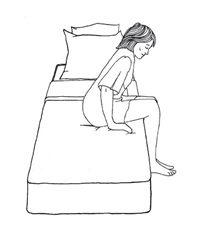 Back up until you feel the bed at the back of your legs. Make sure you’re far enough up the bed towards the pillow.
Back up until you feel the bed at the back of your legs. Make sure you’re far enough up the bed towards the pillow. - Sit down with your bottom as far back on the bed as possible.
- Lower yourself onto the elbow closest to the head of the bed.
- Lift your legs onto the bed as you go down onto your side.
- Lower your head onto the pillow while staying on your side. Use your hand as a support.
- Bend your knees and roll back onto your back.
- If you need to move higher up in the bed, keep your knees bent and push down on your heels. Lift your hips at the same time and move yourself up toward your pillows.
Credit (Image): Calgary Zone Allied Health, AHS
Walking
- For your safety, it’s important to have a nurse or physiotherapist with you the first time you get up after your surgery. Remember to wear comfortable, nonslip footwear.
- At first you may need some help. As you become stronger, you’ll be able to move around more on your own. You may need to take short rests in between walks.
- It’s normal to feel dizzy and uncomfortable when you first get up. Move slowly. If you have more pain or dizziness, please tell your nurse or physical therapist.
- The goal is to be able to walk in the hall several times a day.
If you have any questions about these exercises, please ask your physical therapist or nurse.
